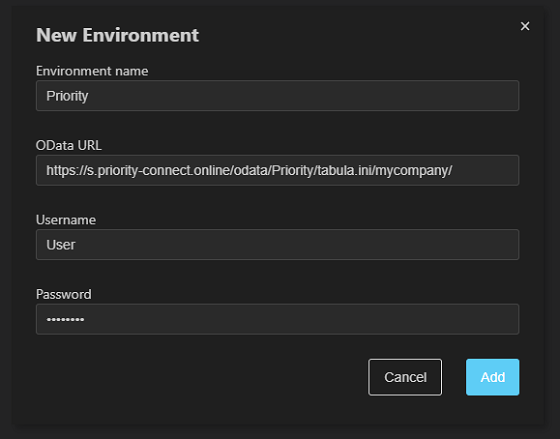VSCode Priority Dev Tools Extension
The Priority Dev Tools extension is currently in beta and some features are still in development.
Introduction
Priority has a dedicated Dev Tools extension available for Visual Studio Code, currently in beta. This extension will assist you in developing quickly and productively in the Visual Studio Code environment.
Features
- Edit, create, and delete Priority form/field triggers
- Edit SQLI steps in procedures
- Syntax check for SQLI
- Code completion for table names, keywords, form fields, and #INCLUDE statements
- Code snippets for most built-in Priority functions
- WINDBI (SQL Development program)
- Navigation between entities using breadcrumbs
- “Go to definition” for #INCLUDE statements and table definitions
- Form and Program preparation
- Code folding
- Vertical ruler
Working Assumptions
To start working the extension, ensure that:
- You have a Priority application server.
- You have an active user in a working Priority Web environment.
- You have a license for the APPVSCODE application (check the Applications for License form).
- You know the URL to access the OData service (run the Send Program Activation Link program).
- Visual Studio Code is installed on your computer.
Setups
-
In Priority, add your username to the APPVSCODE application:
a. Open the Personnel File form and retrieve your username. If you do not have an API User Name, define one now. The user name must be composed of English characters only.
b. Open the Applications for License form.
c. Locate the APPVSCODE application in the Application ID field. If APPVSCODE does not appear, run the Renew License program.
d. Move to the Users for Application subform and add your username.
-
Create an empty folder on your PC. This folder will be used for intermediate WINDBI files.
Add an Environment
-
Go to this link to install the Priority Dev Tools extension.
-
Click the Install button and open the installation in Visual Studio Code.

-
In Visual Studio Code, click the Install button.

-
Navigate to the File menu from the menu bar. Click on Open Folder and select the folder you created in the Setups stage.
-
Press F1 to show the Command Palette.
-
Find and run the command Priority: Open Environments Wizard….

-
Click on Add environment with OData URL.

-
In the Wizard, enter the following information:
Field Explanation Environment name Assign a name for the environment. OData URL Full URL for the OData service, for example, https://s.priority-connect.online/odata/Priority/tabula.ini/mycompany/ Username Your API username Password Your password Alternatively, you can use personal access tokens instead of Username/Password:
-
Open the REST Interface Access Tokens form in Priority, assign a Personal Access Token to your user, and take note of the token.
-
Enter the token in the Username field and PAT as the password.

-
-
Click on Add.
Using the Extension
-
In the Activity Bar (on the left), click the Priority icon
 to see the Environments Explorer. All your environments will appear here.
to see the Environments Explorer. All your environments will appear here. -
Expand an environment to view its tables, forms, and programs.
-
Selecting an object will open it in a new editor window as a file.
-
Saving a file will update Priority.
-
To prepare a form or procedure, run the relevant Prepare operation using the command palette (F1).
-
Press F12 to view the contents of an #INCLUDE statement or a table definition or Alt+F12 to peek into it.
-
Code completion: Press Ctrl+Space to trigger code completion for table names, keywords, form fields, and #INCLUDE statements. If you're unfamiliar with VS Code, click here for general tips.
Using WINDBI
-
Right-click on an environment in the Environments Explorer and select New SQLI to open a new WINDBI window for that environment.
-
In the Environments Explorer, select a company in the Companies panel.
-
To run the SQLI code, click the Run SQLI button in the top-right corner or use the default keyboard shortcut Alt+X.
-
All WINDBI actions are available if you right-click on the environment name in the Environments Explorer.